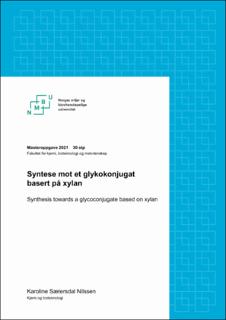| dc.contributor.advisor | Antonsen, Simen Gjelseth | |
| dc.contributor.advisor | Stenstrøm, Yngve Henning | |
| dc.contributor.author | Nilssen, Karoline Sætersdal | |
| dc.date.accessioned | 2021-11-19T14:38:36Z | |
| dc.date.available | 2021-11-19T14:38:36Z | |
| dc.date.issued | 2021 | |
| dc.identifier.uri | https://hdl.handle.net/11250/2830531 | |
| dc.description.abstract | I denne oppgaven skulle xylan hentet fra biomasse fra løvtrær modifiseres, og forhåpentligvis gi ønskede reologiske egenskaper i fôr-pellets. I oppgaven skulle en palladiumkatalysator syntetiseres og brukes til å oksidere xylan, som videre skulle modifiseres til et glykokonjugat.
Første del av oppgaven innebar syntese av en palladiumkatalysator. Denne ble laget gjennom tre steg; først ble (2,9-dimetyl-1,10-fenantrolin)Pd(OAc)2 laget ved å reagere neocuproine og palladium(II)acetat. Videre ble (2,9-dimetyl-1,10-fenantrolin)Pd(MeCN)2(OTf)2 laget ved å reagere produktet fra steg én, (2,9-dimetyl-1,10-fenantrolin)Pd(OAc)2, med acetonitril og trifluormetansulfonsyre. Til slutt ble katalysatoren [(2,9-dimetyl-1,10-fenantrolin)Pd(μ- OAc)]2(OTf)2 laget ved å reagere produktene fra steg én og to.
Videre skulle katalysatoren brukes til å oksidere den reduserende enden av xylan. Denne oksidasjonen ville oksidert C3 hydroksylgruppen til en karbonylgruppe. Deretter skulle palmitinsyre og N-Boc-piperazin kobles sammen i en amidkobling, før piperazin-enheten skulle avbeskyttes. Til slutt skulle amidet kobles til karbonylgruppen på xylankjeden gjennom reduktiv aminering. Denne delen av oppgaven kunne ikke gjennomføres grunnet restriksjoner i forbindelse med koronapandemien. | en_US |
| dc.description.abstract | In this thesis, xylan obtained from biomass from hardwood was to be modified, and hopefully give the desired rheological properties in feed pellets. In the task, a palladium catalyst was to be synthesized and used to oxidize xylan, which was to be further modified into a glycoconjugate.
The first part of the task involved the synthesis of a palladium catalyst. This was made through three steps; first, (2,9-dimethyl-1,10-phenanthroline)Pd(OAc)2 was made by reacting neocuproine and palladium (II) acetate. Furthermore, (2,9-dimethyl-1,10-phenanthroline)Pd(MeCN)2(OTf)2 was made by reacting the product from step one, (2,9-dimethyl-1,10-phenanthroline)Pd(OAc)2, with acetonitrile and trifluoromethanesulfonic acid. Finally, the catalyst [(2,9-dimethyl-1,10-phenanthroline)Pd(μ-OAc)]2(OTf)2 was made by reacting the products from steps one and two.
Furthermore, the catalyst was to be used to oxidize the reducing end of xylan. This oxidation would oxidize the C3 hydroxyl group to a carbonyl group. Then palmitic acid and N-Bocpiperazine were to be coupled together in an amide coupling, before the piperazine unit was to be deprotected. Finally, the amide was to be attached to the carbonyl group on the xylan chain through reductive amination. This part of the task could not be completed due to restrictions in connection with the corona pandemic. | en_US |
| dc.language.iso | nob | en_US |
| dc.publisher | Norwegian University of Life Sciences, Ås | en_US |
| dc.rights | Attribution-NonCommercial-NoDerivatives 4.0 Internasjonal | * |
| dc.rights.uri | http://creativecommons.org/licenses/by-nc-nd/4.0/deed.no | * |
| dc.title | Syntese mot et glykokonjugat basert på xylan | en_US |
| dc.title.alternative | Synthesis towards a glycoconjugate based on xylan | en_US |
| dc.type | Master thesis | en_US |
| dc.description.localcode | M-KB | en_US |

